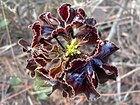Note: This is a project under development. The articles on this wiki are just being initiated and broadly incomplete. You can Help creating new pages.
Jatropha gossypifolia - Bellyache bush
Jatropha gossypiifolia is a much-branched, somewhat succulent, deciduous to evergreen shrub growing up to 3 metres tall.
Contents
- 1 Uses
- 2 Parts Used
- 3 Chemical Composition
- 4 Common names
- 5 Properties
- 6 Habit
- 7 Identification
- 8 List of Ayurvedic medicine in which the herb is used
- 9 Where to get the saplings
- 10 Mode of Propagation
- 11 How to plant/cultivate
- 12 Commonly seen growing in areas
- 13 Photo Gallery
- 14 References
- 15 External Links
Uses
Venereal disease, Heart problems, Diarrhoea, Stomach ache, Indigestion, Thrush, Sores, Bruising, Swellings, Inflammations, Headaches.[1]
Parts Used
Chemical Composition
Common names
| Language | Common name |
|---|---|
| Kannada | Chikka kada haralu |
| Hindi | Ratanjoti |
| Malayalam | Chuvanna Kadalavanakku |
| Tamil | Siria Amanakku |
| Telugu | |
| Marathi | |
| Gujarathi | |
| Punjabi | |
| Kashmiri | |
| Sanskrit | |
| English | Bellyache bush |
Properties
Reference: Dravya - Substance, Rasa - Taste, Guna - Qualities, Veerya - Potency, Vipaka - Post-digesion effect, Karma - Pharmacological activity, Prabhava - Therepeutics.
Dravya
Rasa
Guna
Veerya
Vipaka
Karma
Prabhava
Habit
Identification
Leaf
| Kind | Shape | Feature |
|---|---|---|
| Ovate | Shortly acute | Entire margins with a close row of shortly stipitate |
Flower
| Type | Size | Color and composition | Stamen | More information |
|---|---|---|---|---|
| Capsule | 0.85cm long | Reddish | Reticulate-rugose. Flowering through out the year |
Fruit
| Type | Size | Mass | Appearance | Seeds | More information |
|---|---|---|---|---|---|
| Pods | Smooth and Oval | Contains 3-4 seeds | Fruiting through out the year |
Other features
List of Ayurvedic medicine in which the herb is used
Where to get the saplings
Mode of Propagation
Seeds, Rhizome cuttings, Stem cuttings.
How to plant/cultivate
A plant of the lowland tropics, often found in coastal areas. It is found in areas of Africa where the mean annual rainfall is between 400 - 1,200mm and there is a distinct dry season.[4]
Commonly seen growing in areas
Savannah woodland, Riparian areas, Monsoon vine forests, Coastal foreshores.
Photo Gallery
References
External Links
- Ayurvedic Herbs known to be helpful to treat Venereal disease
- Ayurvedic Herbs known to be helpful to treat Heart problems
- Ayurvedic Herbs known to be helpful to treat Diarrhoea
- Ayurvedic Herbs known to be helpful to treat Stomach ache
- Ayurvedic Herbs known to be helpful to treat Indigestion
- Ayurvedic Herbs known to be helpful to treat Thrush
- Ayurvedic Herbs known to be helpful to treat Sores
- Ayurvedic Herbs known to be helpful to treat Bruising
- Ayurvedic Herbs known to be helpful to treat Swellings
- Ayurvedic Herbs known to be helpful to treat Inflammations
- Ayurvedic Herbs known to be helpful to treat Headaches
- Herbs with Leaves used in medicine
- Herbs with Fruits used in medicine
- Herbs with Stems used in medicine
- Herbs with common name in Kannada
- Herbs with common name in Hindi
- Herbs with common name in Malayalam
- Herbs with common name in Tamil
- Herbs with common name in English
- Habit - Evergreen shrub
- Index of Plants which can be propagated by Seeds
- Index of Plants which can be propagated by Rhizome cuttings
- Index of Plants which can be propagated by Stem cuttings
- Herbs that are commonly seen in the region of Savannah woodland
- Herbs that are commonly seen in the region of Riparian areas
- Herbs that are commonly seen in the region of Monsoon vine forests
- Herbs that are commonly seen in the region of Coastal foreshores
- Herbs
- Pages without herbs images





